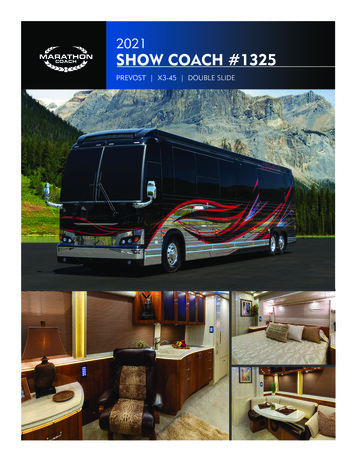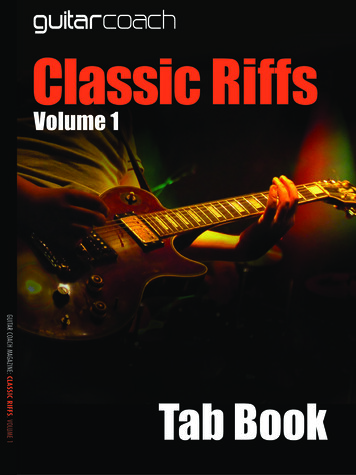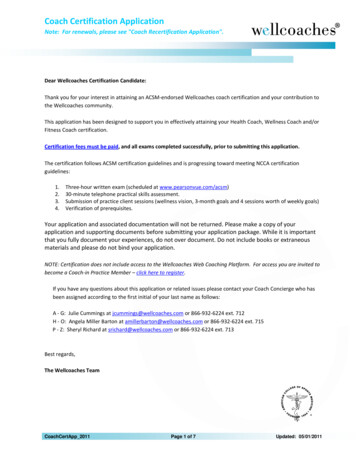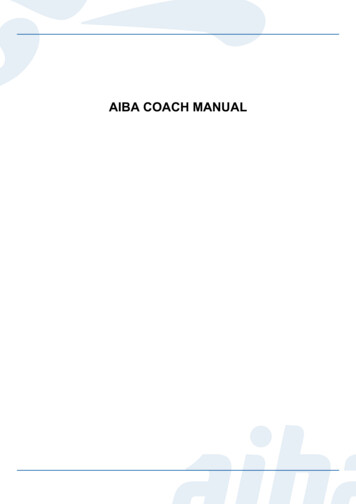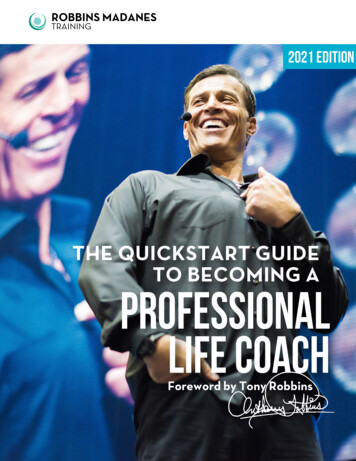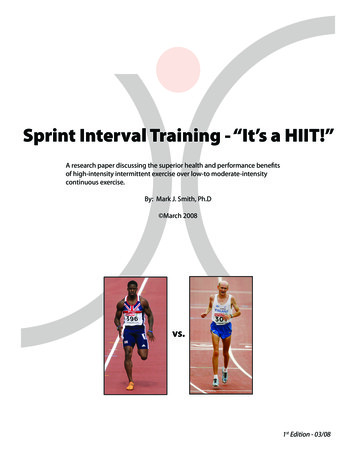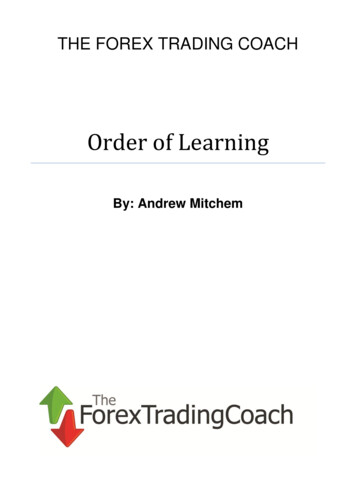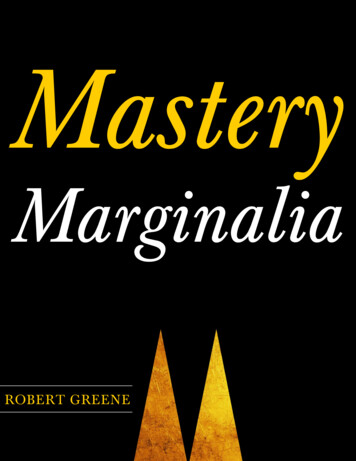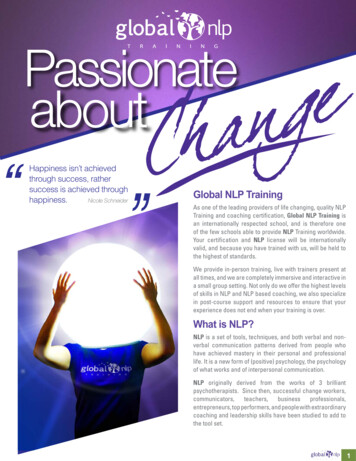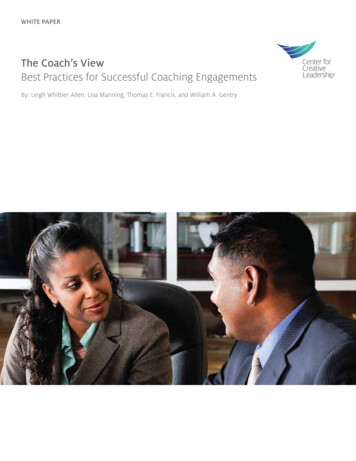
Transcription
WHITE PAPERThe Coach’s ViewBest Practices for Successful Coaching EngagementsBy: Leigh Whittier Allen, Lisa Manning, Thomas E. Francis, and William A. Gentry
ContentsIntroduction1What is a Coaching Best Practice?2Key Findings3Applying Best Practices16Final Words18About the Research18Coaching Practices Glossary20References and Resources24Authors’ Note24About the Authors25
IntroductionExecutive coaching is a growing industryaround the world, particularly for leadershipdevelopment. More than 70% of formalleadership development programs inorganizations use some sort of coaching (Zenger& Stinnett, 2006). And, it’s not just for theC-suite; one survey stated that coaches spendalmost half of their time serving managersat all levels of the organization, not just toplevel management (Sherpa Consulting, 2011).Moreover, coaching is becoming a world widephenomenon. Coaching as an industry is growingon the entire continent of Europe. A recentsurvey stated that there are between 16,000 and18,000 coaches in Europe, and a wide variety ofcoaching practices exist within the continent,with various cultural nuances in the waycoaching is understood and delivered (Carter,2008). Coaching is also becoming increasinglyimportant in Asia with its growing economicand business prominence on the global scene(Wright, Leong, Webb, & Chia, 2010). Because ofthis popularity, numerous coaching models, tools,training, and other resources have appeared.Even so, not enough has been learned aboutwhat makes a coaching process an effective one.A key variable in the success of any coachingengagement is what training and practicescoaches use with their clients. But what exactlyare those practices that result in success? Whatpractices do coaches believe work best to bringabout positive results?To better understand the coach’s view of bestpractices, a team of researchers at the Centerfor Creative Leadership (CCL ) interviewed 87experienced coaches about what they do intheir coaching. Some of them were asked toeven think about their most effective and leasteffective coaching engagements, in additionto specific questions designed to reveal theirspecific practices and processes.Many details emerged from the interviews andmost were grouped into five themes:1. The coachee-centered relationship2. Effective approaches3. Contextual issues4. Models, tools, and techniques5. RolesWith these interviews, we tapped into the realworld experience of coaches to gain practicalinformation about their own best practices foreffective coaching. The interviews also revealthe complexity of coaching and the versatilityrequired by coaches as they tailor coachingengagements to meet individual needs.Our hope is that these insights will providegeneral direction, as well as some useful detailsfor the coaching community. 2016 Center for Creative Leadership. All rights reserved.1
What is a Coaching Best Practice?To get a handle on the methods and practicesthat work well for the coaching process, it helpsto first clarify what we mean by both coachingand best practice.What is coaching? Coaching means differentthings to different people. It can be broadlydefined in terms of a relationship in which the“coachee” (i.e., the one being coached) contractswith a professional (the coach) to facilitate his orher becoming a more effective leader. Coachingcan be used to address a variety of leadershipand work issues including job performance; howto better relate with, deal with or manage others;or career-related issues such as managerialderailment, career advancement, retirement, ordevelopmental opportunities (Bono, Purvanova,Towler, & Peterson, 2009).At CCL and for the purposes of this research,we define coaching as a formal one-onone relationship between a coach and acoachee, in which the two “collaborate toassess and understand the coachee and hisor her development needs, challenge currentconstraints while exploring new possibilities,and ensure accountability and support forreaching goals and sustaining development.”(Frankovelgia & Riddle, 2010, p. 126)2 2016 Center for Creative Leadership. All rights reserved.The working definition of “best practices” forthis research was: “Methods and techniquesdemonstrated and modeled by the executivecoaching professional that have been deemedto be effective and practical when appliedto specific coaching engagements andcontexts.”(Francis, 2011)With this clarity of purpose, the CCL researchidentified many practices that coachesthemselves found to be effective throughanalysis of the interviews. While some practiceswere valued across the board—whethercoaches are working with middle or C-levelexecutives, or whether they reside in Europe orAsia—others differed by context. All practicesreveal important parts of the coaching processfrom the perspective of the executive coachesinterviewed.
Key FindingsThe research provided us with many details of the coaching process. Most of the best practices that emergedfrom analysis of the interviews could be grouped together around five broad themes. (For a list of themes brokenout according to coaching categories, see Table 1. A detailed description of terms is included in a glossary startingon page 20.)Table 1Middle-Level Managers45 Coaches, 11 ThemesC-Level Executives11 Coaches, 5 Themes Results orientation Coachee-centered focus Reflection & guided introspection Facilitator & guide Coachee-centered focus Assessment & development planning Assessment data debrief/interpretation Higher-level processing Self-awareness Trusted advisor & peer Use of various mental models Guided practice Knowledge/application of organizationalcontext (systemic) Holistic approach Inclusion of others as part of coaching initiative(social learning) Organizational applicability and relevanceEurope19 Coaches, 6 ThemesAsia12 Coaches, 10 Themes Approach Assessment & feedback Coach development Challenge Cultural sensitivity Coachee-centered focus Instruments Cultural awareness Relationship building Intuition Techniques Preparation Results-driven Structure Support Utilizing mental models 2016 Center for Creative Leadership. All rights reserved.3
The following gives a summary of the five themes and ways the coaches implemented and used specificbest practices:Theme 1: The Coachee-Centered RelationshipCoaches believe that it is necessary to builda strong relationship with a coachee and thatthe relationship is based on the coachee’sneeds. The process of building the coachingrelationship is coachee-focused, with thecoach serving the coachee.In the coachee-centered coachingengagement, the coachee sets the agendaand direction. Yet, a coachee-focusedapproach does not mean “the client is alwaysright.” The coach is an equal, stepping backfrom being the expert except in some culturesin which the coach is expected to providedirect guidance. The degree to which thecoachee expects the coach to be an expertvaries depending upon the cultural andbusiness context of the coachee. The researchsuggested greater expectations of coaches toadvise the coachee rather than the Westernexpectation of the coachee generating mostof their own facilitated goals and actionsteps. The coach shows respect and buildsrapport through listening, reflecting, andcreating a general sense of safety. In the end,being coachee-centered means believingthat with accurate inquiries, the coachee cangenerate his or her own best solutions in anenvironment of positive regard.The importance of the coach/coacheerelationship is rooted in trust, as one coachworking in Asia said:“I think the quality of relationship we had[was important], so the fact that at onepoint he was able to trust me. I think if thatdoesn’t happen, the coaching relationshipdoesn’t happen.”Coaches also describe building therelationship around who the coachee is andwhat the situation involves, then they bothchallenge and support the coachee with aneye on results. This parallels the CCL modelof coaching, which wraps the coachingRelationship around four other elements:Assessment, Challenge, Support and Results(RACSR). All of the coaches participating inthis study were familiar with CCL’s model.Honest assessment and feedback must be given to the coachees in ways they will be heard and understood.“I’ll do 15–20 interviews in two days. It’s intense,” said one coach who workswith middle-level managers. “When I come home . . . I pull it together in bulletpoints, usually 6–8 pages of the strengths and areas of concern, areas that aretroublesome. In giving the feedback, I always start with strengths because I thinkwe build them and use them in order to get stronger on areas of development.”4 2016 Center for Creative Leadership. All rights reserved.
Challenge and support are closely intertwined, with coaches working to push the coachee andboost learning. One coach, working in Asia, explained:“If you don’t ever challenge the coachee on things and provide supportiveaffirmation all the time, learning may not necessarily be achieved.”Another coach from Asia put it this way:“Support is not always pacifying. It’s about building the relationship and using thedata to corroborate some of the findings which may come from 360 [an assessmentwhere ratings are gathered from the person and his or her coworkers], or the person’sown problems which they share, that this is what I’m struggling on.”Keeping focused on the coachee’s needs and goals requires the coach to ensure measurableobjectives and action steps built into the coaching process. Setting goals, taking action andtracking progress can take many forms, according to the coaches in the study. One coach whoworks with middle-level managers typically uses several steps, including homework based on differentiating a leader vs. manager. Coachees bring their work back to the nextcoaching session. a grid that focuses the coachee on important, but not urgent tasks. The coach has the coachee createa four-quadrant grid:1. Important/urgent2. Important/non urgent3. Non important/urgent4. Non important/non urgent. This creates a picture of what matters most and what gets in the way. a learning history. The coach completes a summary of outcomes before the first and the last session,including themes, context, and learning history. The learning history includes mapping the goals andwhat the coachee has accomplished, how it was accomplished, and what qualities he used.Another coach noted:“The coach tries to help coachees look at their leadership on severaldifferent levels, and not the goals the coach may be inclined to have forthe coachee. The coach is very goal-oriented; he or she talks about goalsand ways to implement them into each session.” 2016 Center for Creative Leadership. All rights reserved.5
Theme 2: Effective ApproachesCoaches conduct their work in different ways. In the interviews, they refer to their coaching styles, as well asspecific frameworks or lenses, on their approach to coaching assignments.Coaches will vary their approach based on the coachee or context. Coaches working with middle-level managersreport that an approach of reflection and guided introspection is a best practice. Coaches are facilitators, helpingto slow down the coachee’s thoughts and provide time for reflection. One coach described her style as looking for:“. . . word choices, tone, listening for pauses and fortightness in the voice. I reflect it back and respondon what I’m hearing from the words being said andthe sounds she’s making. [For example] When mycoachee heard this, it caused her to pause. She wasshocked at how she was coming across. She thenimmediately connected that with the tightening inher gut that she was feeling.”Another coach had a similar take:“I serve as a mirror to show the coachees how they’redoing . . . I’m coaching in the moment about whatI see and experience from them. [Then I] get thecoachees to look at how they feel about their ownbehavior. I ask them, Would you work for you?”6 2016 Center for Creative Leadership. All rights reserved.
The best practices in Asia revealed a different approach. Coaching engagements had structure,but coaches needed to adapt during the time with their coachee as well:“So it was in there but I think the need to customize to adapt andflex and tailor is so much part of the coaching process anyway that ithappens naturally, not just for cross-cultural issues, it happens becauseit needs to happen because everybody is in a different role and have gotdifferent goals, got different needs, different preferences.”Coaches of C-level executives tended to approach coaching with a focus on personal growth andleadership legacy. They expressed an approach that uses creativity and offers solutions. Threeexamples from coaches included:“I think a visual image and a story . . . that’s accessing the rightbrain. I think for most of us, that is extremely powerful and morepowerful than just reading a bullet point.”“It’s an opportunity for you as a CEO to take a look at who youare and the kind of leadership shadow that you cast because yourshadow is long and you may not have a way of really seeing whatthe impact of that shadow is unless we take a very close look.”“People usually seem to want to talk about deeper values, wherethey find their meaning in life, what kind of contribution they’remaking to the planet, not just their organization.” 2016 Center for Creative Leadership. All rights reserved.7
Theme 3: Contextual IssuesCoaches cannot coach in a vacuum. They have a range of practices tohelp them grasp the organizational context and issues. This includeshaving a perspective on the key drivers, the organizational structure androle expectations. The coach must also understand the pressures of thecoachee’s job and the organizational hierarchy.The coach may gather and assess the context in a number of ways,including site visits, examination of organizational charts, goal alignmentmeetings between the coachee and the coachee’s boss, needs assessments,and direct insight from the coachee.Coaches working with C-level executives were well aware they wereworking with executives at the highest levels of organizations who havevery complex problems that not many others in organizations face. Ascoaches, they described the need to conceptualize things at a faster rate,to think through complexity, and help these executives “connect the dots”between their assessments, the behavioral observations and the futurechanges the executive is planning.Several examples emerged from the interviews of the coaches who workedwith C-level executives. Three different coaches discussed this issue:8 2016 Center for Creative Leadership. All rights reserved.
“The degree of impact of what CEOs are going to talk about can havefar more effect that we need to be very cognizant of the importanceof their role, and at the same time, respecting the fact that CEOsoften live in a fairly isolated environment.”“They [coachees] may be aware of some of the positives and some ofthe negatives but they may have missed some of the implications oftheir behavior and what influence it has on the larger organization.”“Every leader needs to think about an information pipeline comingto them, and everything that they do to keep that pipeline open isgood, and anything that they do to constrict that pipeline is badbecause they need that good information to make good decisions.The decision quality can only be as good as the information.” 2016 Center for Creative Leadership. All rights reserved.9
Coaches working with middle-level managers need to have an appreciation of the coachees’ “stuckin the middle” context. To effectively work with this group in particular, coaches mentioned helpingcoachees understand the bigger picture—both of their organization and of their personal situation.To get a systems perspective of a coachee’s context, one coach described the following:“I go over once a year and conduct an on-site visit. I alwaysinterview his direct reports, peers and his boss in person at that time.I then have verbatim feedback on the questions that he and I havecome up with in advance regarding the goals he set for himself.”Coaching in context is not just about work, it’s about looking at the whole person. Another coach said:“The coach’s model is to go beneath the surface to get to who theyreally are and how they can express that in their lives and in their worksetting . . . the coach is very focused on work-life balance. The coachfocuses on the whole person and how he or she can only contribute tothe organization if he or she is being authentic and committed.”For coaches in Europe and Asia, the contextual issue appeared primarily as a cross-culturalissue. These coaches emphasized the personal responsibility that they take to prepare to workin different cultures and with people from cultures other than their own. One coach from Europegave the following piece of advice:“I would also suggest, and one of the things that I do when I knowthat I’m going to coach somebody from another country that I’venever coached from before, to gather as much information as I canabout that country and the culture.”10 2016 Center for Creative Leadership. All rights reserved.
Another said the following:“Most important thing in cross-cultural coaching, never toassume you are an expert in any culture—even your own.”A third coach from Europe gave this specific example:“Because I know Dutch culture to a certain extent, I couldunderstand not only his ‘Dutch-ness’ but the part ofthe country he comes from. So I have what I call culturespecific knowledge that helped.”A coach working in Asia advised other coaches in this way:“If you’re going to work with people of different cultures, orgenders, or sexual orientations, you actually have to work onyour feelings about that group of people. And some of it isdealing with your own racism, your own colonialism, your ownimperialism, your own sexism, and actually facing up to it.” 2016 Center for Creative Leadership. All rights reserved.11
Theme 4: Models, Tools, and TechniquesOne common theme of the coaches working with middle-level managers,and those working in Europe and Asia, was that they discussed the variousmodels, tools, and techniques that they typically used in coaching sessions.Some coaches described general processes, including reflection, guidedpractice, appreciative inquiry, and assessment and feedback. A coach whoworks with middle-level managers gave the following example:“I have a heavy emphasis on working with Appreciative Inquiry . . . theperson does have many inner strengths and resources that we need todig for. Helping them to bridge past success to future action—this isa powerful part of the model. I have come to appreciate that peoplein general don’t enjoy just jumping off the edge to new behaviors. Sowhen a coach can dig for parallel issues and have the coaching clienttell stories of past successes in something parallel, it’s very powerful.”Other coaches mentioned specific instruments (Benchmarks, Myers-Briggs)or models (Assessment-Challenge-Support) or frameworks (Hofstede,Trompenaars, Edward T. Hall). Some also mentioned use of specifictechniques such as “use of various mental models,” “inclusion of others aspart of coaching initiative,” “finding mentors,” and “role play.”12 2016 Center for Creative Leadership. All rights reserved.
“Role play is a “must have,” said one coach. “Frequently, I’ll be thecoachee, because usually the coachee knows the other party so muchbetter than me. So, I’ll say, ‘Why don’t you be Sam or Suzie and I’ll beyou. Let’s play this out two ways—I’m going to do what you said you didand I’m going to ask you for how that experience was. Then I’m going togive you another option and ask you how that sounds and feels for you.”A coach from Europe shared this technique:“I’m usually thoroughly conscious of the timeframe, trying to coverso much ground. And one tool I’ve found to be highly effectivewith a number of coaches is a list on a flip chart . . . to summarizethe session. They give the main points. I maybe add some. Did wediscuss this as well? How shall we express this?”Involving others can take place in a number of ways. A coach of middle-level managers suggests the following:“Encourage the coachee to select two people:1. A mentor, maybe the boss or someone high up, who canpolitically give them information and advice on what they wantto do, who they want to connect with, how they go about doingthings they haven’t done before;2. A direct report, or secretary or peer. It can be anybody. I askmy coachee to tell this person one or two issues they are workingon . . . this says to that person, I trust you. I value your opinion.I value you as a person. It’s a huge compliment because it’s risktaking and allowing yourself to be a little vulnerable.” 2016 Center for Creative Leadership. All rights reserved.13
Theme 5: RolesA final theme that emerged from the interviews with coaches is the importance ofhaving clarity around their role. This was apparent to coaches working with C-levelexecutives and middle-level managers.For those who work with C-level executives, the coach takes on the role of trustedpeer and advisor. The coach needs to have solid standing with the coachee and beable to interact on an equal level of influence.One coach said:“Some of the courage that a coach needsto have the ability to be able to challengewhere it seems appropriate and try to reallyunderstand what’s driving certain behavior,and getting under their skin a little bit.”14 2016 Center for Creative Leadership. All rights reserved.
When talking about C-level coachees, one coach said:“No matter how successful they were, they needed assistanceand were looking for assistance, and grateful for it because therearen’t many places that they can go. You want to be able tofunction with them as a peer.”For coaches of middle-level managers, the coach’s role is to help the coachees become moreself-aware and to put their experience in a larger context. As one coach described:“I put things in perspective and normalize their feelings. I let themfeel like I’m someone who can relate and can be open about myown pluses and minuses. I do that a fair amount to help peopleunderstand that they are not completely alone in the world on[their issues]. 2016 Center for Creative Leadership. All rights reserved.15
Applying Best PracticesA focus on these five themes is a useful way for coaches to understand and implement best practices in coachingengagements. To assess your own coaching practice in terms of the best practices revealed in this study, considerthe following questions:How can I ensure I am keeping coachees at thecenter of my coaching practice? What are theirneeds and goals? Just as important, a coacheecentered approach relates to beliefs a coach has aboutthe coachee and the positive regard in which coachesmust hold their coachee.How might I deepen my understanding of thecontextual issues facing my coachees? Considernational culture and language—but also organizationalculture and systems as well as the coachee’s level andfunction in the organization. Also, work to learn moreabout industry trends and global economics.What different approaches might I try with currentcoachees or with different clientele? Explore yourown patterns and preferences and consider whethera new approach or angle may be better suited to aspecific situation or client. As with your coachees, theprocess of reflection and self-awareness may lead tonew ideas and opportunities. At a deeper level, youshould be considering the coachee’s personality styleor work context, and you need to be able to preparethe data into ways the coachee is best able to hear andunderstand.What other models, tools, or techniques mightbe valuable? What tools are in your toolkit? Whatframeworks or techniques could you employ but rarelydo? Are there topics or situations that might lendthemselves to something new or different from you?How could you seek out or practice new models ortechniques?Could I play a different role with any of mycoachees? What do they want or need, and might thatrequire me to take on a new role or adjust the scope ofthe coaching engagement?Another useful tool is RASCR, the CCL model of coaching. Our coaches and clients often find that it is a helpfulframework for clarifying and focusing the coaching process. Consider the following tips as you reflect on what youmight learn or improve in your own development as a coach.16 2016 Center for Creative Leadership. All rights reserved.
RelationshipsHow well do you establish boundaries and build trust? To establish an effective coaching relationship, you needto, among other things: Be clear about learning and development objectives. Be patient. Show good, sound judgment about whichinformation to use with the coachee and whetherthe timing is right to share other, more sensitiveinformation with him or her. Show integrity. Be clear about the impact of your own behavior onthe coachee. Follow through on promises or agreements. Continually show that you have the coachee’s bestinterests in mind.AssessmentDo you skillfully help others to gain self-awareness and insight? If so, the actions you take will include the following: Provide timely feedback. Explore the gap between current performance anddesired performance. Help gain clarity about behaviors that the coacheewould like to change. Note inconsistencies between words and actions. Help the coachees discover situations in which theirimpact is different from their intentions.SupportHow well do you listen? Are you able to understand the coachee’s perspective and find ways to engage him or her inthe coaching and development process—even through difficulty? Support comes in many forms, including: Listening carefully to the ideas and suggestions ofothers. Encouraging employees to make progress towardtheir goals. Being open to the perspectives of others. Recognizing the success of employees. Allowing employees to vent emotions withoutjudgment.ResultsDo you help the coachee set meaningful goals and be accountable for them? If so, you are likely to helpemployees identify: Goals that will have the greatest positive impacton their effectiveness. Specific metrics and milestones that employeescan use to measure progress toward their goals. Specific behaviors that will lead to achievingtheir goals. 2016 Center for Creative Leadership. All rights reserved.17
Final WordsGiven the scope and importance of coaching across organizational levels and aroundthe world, it is essential for coaches to understand the best practices of other effectivecoaches. Clearly, the field will require more research, as well as ongoing interactionamong members of the global coaching community. For instance, interviewingthose who sit on the other side of the coaching engagement would be important;understanding what coachees believe are best practices used by their coach would bea critical piece of information to obtain and discover. In addition, understanding what“success” in coaching looks like, and how to measure it, would greatly contribute tothe research and practice of coaching. By understanding coaching best practices fromthe perspective of those who coach, this first step in research will help other coaches tofine-tune their own approach and learn how to best coach their coachees, regardless ofcircumstance, level in the organization, or cultural context.AppendicesAbout the ResearchParticipantsCCL researchers interviewed 87 experienced coachesin three phases. All participants were professionalcoaches, trained in the CCL methodology andconsidered independent contractors with CCL. Theyrepresented a range of credentials, backgrounds andexperience, including those who work with middlelevel managers, C-level executives, and those workingin Asia and Europe.The first phase of the project examined the practicesof coaching middle-level managers and includedinterviews with 45 coaches (21 male and 24 female).A representative sample of coaches from each ofCCL’s three North American campuses (10 from SanDiego, 11 from Colorado Springs, 12 from Greensboro)were included, as well as six coaches each from thecampuses in Brussels and Singapore. The intervieweesare professional coaches who make their living18 2016 Center for Creative Leadership. All rights reserved.coaching, and were identified as high-performingcoaches. Each coach had been involved in at least15 coaching engagements with consistently positiveresults.The second phase sought to capture cross-culturalnuances in coaching. Researchers interviewed 12coaches who were living in Asia (seven men and fivewomen) and 19 located in Europe (13 women andsix men). The coaches represent different countries,including Australia, China, Germany, Singapore, GreatBritain, India, The Netherlands and the United States.The final phase focused on coaching C-level executives.In this phase, 11 coaches working with C-levelexecutives were interviewed. The coaches averaged 17years of coaching experience with C-level executives.
Interview ProtocolDuring the development of the interview protocol, CCL researchers consulted with 15 CCL coaching staff andcoaches to ensure the essential elements of the coaching process were addressed. The interview protocol askedthe coaches to describe two critical incidents from their coaching engagements: what the coaches considered tobe their most effective coaching engagement and what was their least effective coaching experience. Coacheswere asked to describe what their specific coaching practices looked like, i.e., what was actually said and done inthese sessions. Coaches were sent the interview protocol in advance and asked to consider and review their casefiles in preparation for the interview.AnalysisInterviews were transcribed into the qualitative analysis software, ATLAS.ti (Muhr & Friese, 2004). To identifyand code best practices (themes) in the data for each r
this popularity, numerous coaching models, tools, training, and other resources have appeared. Even so, not enough has been learned about what makes a coaching process an effective one. A key variable in the success of any coaching engagement is what training and p

